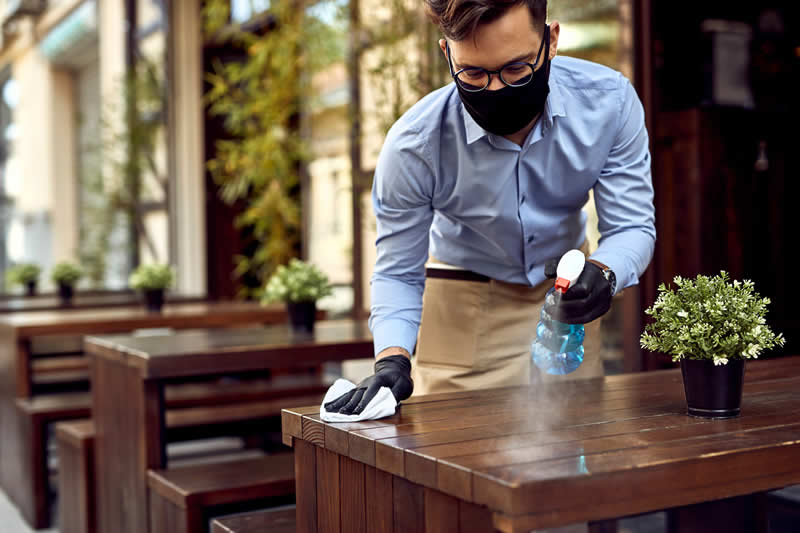Restaurants Getting Back to Business: How restaurants are adapting to new Covid-19 measures

Adapting to new safety measures in a pandemic
From fast food to fine dining, restaurants have always provided a place to gather with family and friends to celebrate birthdays, anniversaries and other milestones, or just to provide a night off from cooking dinner. As restaurants begin opening their doors and resuming business, it’s definitely not business as usual.
The dining experience of just a few short months ago looks very different today, as restaurant operations are adapted, and adjustments are made in order to meet new public health and safety guidelines outlined by the government, as well as reassure patrons that they are entering a safe environment to dine in. Although food safety was always a top priority in the food industry, now the health and safety of restaurant guests also need to be included in the restaurant operations.
Many restaurants began their re-openings by allowing limited patio dining. Patios offer an open-air solution to socially distanced dining. However, with the imminent Canadian fall and winter seasons, restaurants have adapted their indoor dining rooms to meet new guidelines and safely welcome their guests. Restaurant owners are also putting a greater emphasis on online ordering, delivery and takeout, with platforms such as the Canadian based Ritual providing a no fee way to connect you to your customers for online orders both quickly and easily.
While some restaurants around the world are experimenting with more extreme changes, such as utilizing robots to take orders, deliver food to tables, and even pour pints, there are some more manageable changes that are more easily implemented by those in the restaurant business.
Creating social distance
It’s not always possible to move tables apart to create the recommended space for social distancing. Fixed tables and booths mean some restaurants have adapted in other ways to distance people if they can’t physically be 6 feet apart.
Physical barriers
Some restaurants have had shields and dividers installed to maintain health and safety standards and help isolate tables and diners from one another. Whether it’s a shield dividing an individual diner from the person across the table from them, or a ‘pod’ to create a barrier between each table, these physical barriers allow diners to enjoy their meal without coming into contact with others in the dining room, even when the recommended distance of 6 feet apart cannot be maintained.
Place fillers
To help avoid the eerie and desolate look of an empty dining room, some business owners have opted to use place fillers sat at their tables, such as mannequins or stuffed teddy bears. It’s a quirky way of maintaining health and safety standards by creating space between diners, without the hassle of rearranging the dining room or installing physical barriers. Some restaurant owners have even partnered with local fashion designers and clothing shops to dress the mannequins and promote their products.
Masks
Part of the allure of the restaurant experience is the interaction with the staff – and servers and other waitstaff generally rely on the tips they get based on their guest engagement and the level of service they are providing. Having staff wear masks or face shields while interacting with guests means they can still have that personal guest engagement while limiting the risk and physical contact. It’s a simple solution that makes it easy to get back to business almost as usual. And, you can even customize your masks with your logo and branded colours and provide them to staff as a matching component to their uniforms.
Offering ordering options
The more options patrons have for filling their bellies with your menu items, the more likely they are to find one that suits their needs. This helps broaden your revenue streams, increase restaurant sales, keep your customers interested and shows them you’re willing to adapt to their needs.
Takeout and delivery
Although this has been an option for many in the food industry for some time, adjustments have been made to how takeout and delivery orders are fulfilled. Contact-less pickup and delivery have become popular options, where orders are pre-paid, and there is no need for physical contact between anyone. Many restaurants have even opted to offer free delivery to help increase the number of orders.
Contact-less ordering
It seems that the days of physical menus may be long gone as menu innovation replaces these with digital formats. There are many options available for contact-less ordering platforms, each offering different features at varying price points. A mobile app or QR code gives customers easy access to your menu, right on their mobile device, allowing them to browse, order and pay with a credit card without ever having to come into contact with anyone. Even if you don’t have much technical experience, you can use a QR code generator like Tidy Menu or BackBar to build a PDF menu that’s mobile-ready.
Getting innovative
The restaurant industry can be highly competitive. Differentiating your restaurant business by offering unique add-ons can help separate you from the competition and give you an exclusive edge to enhance the guest experience. This way, the next time they are looking to order from a restaurant, they are more likely to remember their unique experience.
Drinks to go
Many restrictions have been lessened around restaurant and bar sales of alcohol in the last while. This has allowed restaurants to begin offering alcohol to go as an add on to their regular food and beverage menu. Suppose your restaurant offers exclusive cocktails or craft beers. In that case, you may want to consider putting together DIY cocktail kits or take away 6-packs, so your customers can enjoy your creative concoctions at home, and you can enjoy new revenue streams.
If you’re known for your perfect wine pairings, suggesting a bottle of wine to pair with each order can help move your cellar stock and enhance the customer’s at-home dining experience.
Buy and give
During this time, there are a number of people who could use a helping hand, from overworked frontline workers to those who have lost employment as a result of the coronavirus pandemic. People are coming together to find ways to support their communities, show their appreciation for those working hard on the front lines, and help those in need. Donating meals has become popular for many local restaurants, to help their communities and show the philanthropic side of their restaurant business. Whether it’s showing up at a hospital with lunch for the workers or promoting a ‘buy one, give one’ program to help local food banks, showing that you’re helping to support the community is a great way to elevate your restaurant’s reputation.
DIY dinners
Offering fun deconstructed dishes gives your patrons the chance to put together their favourite family meal at home, with all of the ingredients pre-chopped, measured and ready to go. This is especially beneficial for meal options that don’t travel well for takeout or that can’t easily be packaged. It also gives customers the opportunity to order a meal kit now and make at their convenience.
While things may not be returning to ‘business as usual’ any time soon, there are many unique ways that you can adapt your business model and restaurant operations to these changing times. As the restaurant industry begins reopening, it can help make things a little bit more familiar and keep your restaurant sales active. With every challenge, new opportunities will arise. Take a look at the potential opportunities that you have to keep your business active and rise to the occasion, even during these challenging times.
Ontario Business Central has helped thousands of new and existing restaurants to start or change their existing businesses. Should you have any questions, please feel free to reach out to our staff for additional information and assistance.
inquiries@ontariobusinesscentral.ca
Toll-Free: 1-800-280-1913
Local: 1-416-599-9009
Fax: 1-866-294-4363
Office Hours: 9:00am – 5:00pm
Monday – Friday E.S.T.
Ontario Business Central Inc. is not a law firm and cannot provide a legal opinion or advice. This information is to assist you in understanding the requirements of registration within the chosen jurisdiction. It is always recommended, when you have legal or accounting questions that you speak to a qualified professional.


